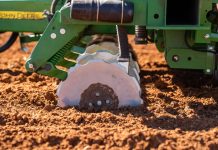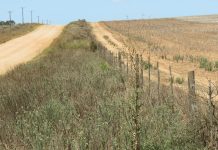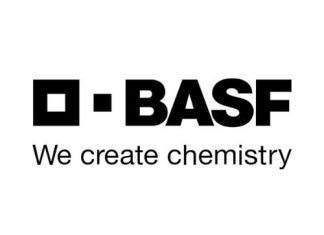
van Rensburg,
ARC-Grain Crops, Potchefstroom
 Dr Bradley Flett,
Dr Bradley Flett,ARC-Grain Crops, Potchefstroom
 Dr Henry Njom,
Dr Henry Njom, ARC-Grain Crops, Potchefstroom
Conservation agriculture (CA) is a systematic approach that discourages soil disturbance by integrating zero tillage, permanent soil cover and crop rotation to establish a balanced, sustainable agro-ecosystem.
This approach ensures the efficiency of cropping systems by enhancing the quality of the soil through an increase in organic carbon, soil bulk density, nitrogen, microbial diversity and soil moisture conservation. When environmental conditions are favourable, a lack of crop rotation under no-till may have an impact on mycotoxigenic Fusarium spp. infections and resultant mycotoxin production in grain.
The fungi that produce mycotoxins in grain are broadly placed into two groups: those that invade before harvest, commonly called field fungi, and those that occur only after harvest, called storage fungi. Examples of economically important toxigenic field fungi of maize are Fusarium verticillioides (Photo 1) and Fusarium graminearum (Photo 2). These fungi can produce mycotoxins called fumonisins (F. verticillioides), deoxynivalenol and nivalenol (F. graminearum). Furthermore, F. graminearum can produce an estrogenic metabolite called zearalenone. Fungal infection and colonisation of grain may lead to poor grain quality, whereas mycotoxins may have a negative health impact on humans and animals.
There is a perception among grain producers that CA systems increase ear rots and mycotoxins in maize grain. Therefore, the ARC-Grain Crops conducted a study (funded by the Maize Trust) to see what is happening at CA farm level.


Samples from commercial production areas
28 maize grain samples (2019/2020 season) and 25 samples (2020/2021 season) intended for human and animal consumption were collected from four commercial producers (in Kroonstad, Makwassie, Ottosdal and Reitz) in the north-eastern production area in South Africa. Each producer used different CA practices suitable for their specific local production systems. These samples varied over locality and season.
Monoculture maize fields planted to CA principles were selected as controls. Ear rots such as F. verticillioides and F. graminearum were quantified, using qPCR analyses. Multiple mycotoxins such as fumonisin (FUM), deoxynivalenol (DON), 15-acetyl DON (15-A DON), ochratoxin, zearalenone (ZEA), T-2 toxin, HT-2 toxin and diplodiatoxin (DT) were analysed by the Southern African Grain Laboratory (SAGL) using a LC-MS/MS method.
Samples from small-scale production areas (KwaZulu-Natal)
37 maize grain samples were collected from eleven small-scale farmers (Mayizekane [3 farmers], Eqeleni, Stulwane, Ezibomvini, Vimbukhalo, Spring Valley, Emabunzini, Ndunwana and Madzikane) situated throughout the KwaZulu-Natal small-scale production area in South Africa during the 2019/2020 season. These farmers are all part of the Mahlathini Development Foundation, which aims to increase the use of CA (no-till) among small-scale farmers. Each farmer used differing CA practices (monoculture maize, cowpea/maize rotation and/or dry bean/maize rotation). Monoculture maize fields planted to CA principles were selected as controls. Ear rot and mycotoxin quantifications are the same as described for the commercial production area samples.
Results
Samples from commercial production areas
In Kroonstad (northern Free State), both samples collected in 2019/2020 contained low amounts of F. verticillioides and F. graminearum. Mycotoxin quantifications for FUM, ZEA, DON and 15-ADON were low and insignificant to human or animal health. In 2020/2021 the fallow/maize/maize system had significantly dangerous levels of DON (1 604 parts per billion [ppb]), while no mycotoxins were detected during this season at the sorghum/maize/maize and soybean/maize intercrop.
In Makwassie (North West Province), the monoculture maize sample (2019/2020) had a DON level of 1 020 ppb, which exceeds legal limits for pigs and pet food, while all other mycotoxins were lower than the legal limits. Monoculture maize had lower mycotoxin levels than maize planted on a fallow land followed by maize, where the maize ear rot F. graminearum was extremely high (6 455 pg/20µl) with resultant toxic DON (7 144 ppb) and ZEA (26 193 ppb) levels. In a field of maize where groundnuts were planted the previous season, the ear rot F. graminearum (881 pg/20µl) was high and resulted in toxic levels of DON (9 619 ppb). In the 2020/2021 season, monoculture maize had very low DON levels and no other mycotoxins were detected. Maize following sunflowers had no mycotoxins detected.
In Ottosdal (2019/2020 and 2020/2021), monoculture maize sampled in fields with different plant populations had no or very low ear rots and resultant mycotoxins.
In Reitz during the 2019/2020 season, the monoculture maize had moderate infections of F. verticillioides ear rot (45,3 pg/µl) as well as higher infections of F. graminearum ear rot (458 pg/µl). Although various related mycotoxins were detected, they were lower than the allowed legal requirements. In maize following a grass cover crop, F. verticillioides (70 pg/µl) and F. graminearum (129 pg/µl) ear rot infections were low and no mycotoxins were detected. On maize following a sunflower crop, F. graminearum ear rot infections were low (64,4 pg/µl) and again no mycotoxins were detected.
Samples from small-scale production areas (KwaZulu-Natal)
In Mayizekane (farm 1), the monoculture maize sample had a high F. graminearum (1 126 pg/20µl) infection with a low level of ZEA (354 ppb). The maize sample intercropped with dry beans had levels of F. verticillioides (7,4 pg/20µl) and F. graminearum (350 pg/20µl). The resultant FUM (752 ppb) and ZEA (85 ppb) levels were within acceptable limits. The maize sample intercropped with cowpeas had a low F. verticillioides infection level (70,5 pg/20µl), but a high F. graminearum infection level (2 386 pg/20µl), with a ZEA level (4 294 ppb) exceeding the legal limit for pigs, calves and dairy cattle.
In Mayizekane (farm 2), the monoculture maize sample had low F. verticillioides (128 pg/20µl) and F. graminearum (38 pg/20µl) infections. The FUM level (2 266 ppb) did not exceed the legal limit. The maize sample intercropped with cowpeas had a low infection rate for F. graminearum (82,7 pg/20µl), but the ZEA (976 ppb) level exceeded the legal limit for calves and dairy cattle.
In Mayizekane (farm 3), the monoculture maize sample had low F. verticillioides and F. graminearum infections (24 pg/20µl and 67 pg/20µl, respectively). The FUM level (6 896 ppb) exceeded the legal limit for humans, horses and pets. The maize sample intercropped with dry beans had low F. verticillioides (25 pg/20µl) and F. graminearum (146 pg/20µl) infections, with corresponding low levels of FUM (105 ppb), 15-A DON (105 ppb) and ZEA (29 ppb). F. verticillioides and F. graminearum infections were high in the maize samples intercropped with cowpeas (779 pg/20µl and 1 152 pg/20µl respectively).
In Eqeleni, grain from four monoculture no-tilled maize fields were sampled and infection rates of F. verticillioides and F. graminearum varied from 0 to 3 pg/20µl and 3 to 231 pg/20µl, respectively. FUM was not detected in any fields and DON levels varied from 240 to 798 ppb (all below the legal allowable limits). 15-ADON varied from 0 to 208 ppb and ZEA from 0 to 144 ppb, which were also all below the legal allowable limits.
In Stulwane, three maize/cowpea intercrop fields were sampled. Low infection levels in grain were quantified for F. verticillioides (35 to 51,2 pg/20µl) and F. graminearum (17 to 221 pg/20µl). In grain sampled from two maize monoculture fields, F. verticillioides and F. graminearum were also low (12 and 81 pg/20µl and 90 and 102 pg/20µl, respectively). One grain sample had a DON level of 1 665 ppb, making it toxic to pigs and pets. Very low levels of ZEA were found in maize grain from monoculture fields (49 to 78 ppb).
In Ezibomvini, two monoculture maize fields, one maize after a cover crop and five maize/drybean intercropped lands were surveyed. Maize grain from the monoculture fields had low F. verticillioides (7,9 and 17 pg/20µl) and F. graminearum (21,4 and 85 pg/20µl) infections, with corresponding low mycotoxin levels. The DON level in one sample was 1 950 ppb, making it toxic to pigs and pets. Similarly, maize grain (following a cover crop) had low F. verticillioides (34 pg/20µl) and F. graminearum (100 pg/20µl) infections.
The FUM level was low at 240 ppb, DON was 1 418 ppb (making it toxic to pigs and pets), 15-A DON was 518 ppb and ZEA was 107 ppb. The five maize/drybean intercrop fields had low F. verticillioides infection levels varying from 0 to 4,4 pg/20µl and low F. graminearum infection levels varying from 0 to 595 pg/20µl. Three of the fields had no FUM, where the other two had levels of 127 and 379 ppb and only one field had DON (121 ppb). Otherwise no mycotoxins were detected in the drybean/maize intercropping systems.
In Vimbukhalo, three monoculture maize fields were sampled, one cowpea/maize intercrop and two drybean/maize intercrop fields. In the monoculture maize fields, low infection levels of F. verticillioides (1,3 to 35 pg/20µl) were observed. Trace amounts of mycotoxins were detected in the monoculture fields. In the maize/cowpea intercrop field, no ear rot pathogens or mycotoxins were detected. F. verticillioides infections in the two maize/drybean intercrop fields were low at 1,4 and 10,2 pg/20µl. F. graminearum was present in one grain sample (2,4 pg/20µl). No mycotoxins were detected except for one field where 399 ppb DON were detected.
In Spring Valley, a maize monoculture field and a maize/drybean intercrop were sampled. In both fields the infection with F. verticillioides (134 and 4,6 pg/20µl, respectively) was low. No F. graminearum was detected nor any mycotoxins except FUM levels of 81 ppb in the monoculture maize sample.
In Emabunzini, a maize/drybean field intercrop was sampled where F. verticillioides had a low infection of 39 pg/20µl. F. graminearum and mycotoxins were not detected.
In Ndunwana, a monoculture maize grain sample had low F. verticillioides infection levels (4,8 pg/20µl) with no F. graminearum detected. No mycotoxins were detected except for ZEA (56 ppb), which is very low.
In Madzikani, grain from a monoculture maize field had a F. verticillioides infection of 47,7 pg/20µl with no mycotoxins detected.
Conclusion
Samples from commercial production areas
Although there were no tendencies regarding the effect of the rotation/CA system on mycotoxigenic ear rot fungi and/or mycotoxins, there was variation among localities regarding both mycotoxigenic fungi and mycotoxins, with Makwassie having the highest DON and ZEA levels. Ottosdal had the lowest levels of fungi and mycotoxins. This area was previously known for high levels of F. verticillioides and FUM. However, it appears that in recent years levels of F. graminearum and related mycotoxins have been on the increase.
Samples from small-scale production areas (KwaZulu-Natal)
Although there were no clear tendencies regarding the effect of the cropping system on mycotoxigenic ear rot fungi and/or mycotoxins, it appeared that the maize/dry bean intercropping system had lower mycotoxigenic fungi and mycotoxins than other cropping systems.
The variation among localities (environmental conditions) regarding both mycotoxigenic fungi and mycotoxins, was greater than the cropping systems themselves.
 Acknowledgements
Acknowledgements
The authors would like to acknowledge all the participating producers as well as Erna Kruger and Mazwi Dlamini from the Mahlathini Development Foundation, Hannalien Meyer from the SAGL who conducted the multi-mycotoxin analyses and Desmond Nkoko (ARC field technician) for assistance with sample collections.




























